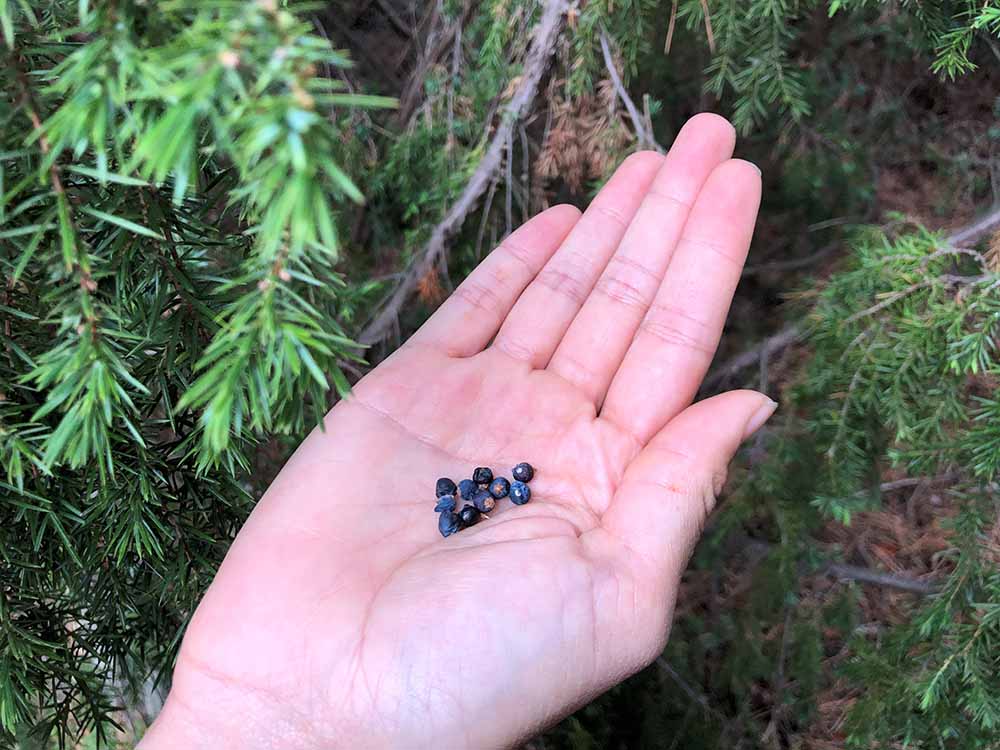Juniper is the main ingredient of all gin. Let’s delve a little deeper into what it actually is!
Juniper or common juniper is a shrub or small tree which is a species of conifer. Conifers are plants which have cones bearing seeds and needle like leaves and are usually evergreen. While there are many types of juniper such as Chinese juniper (juniperus chinensis), Rocky Mountain juniper and Cade juniper (juniperus oxycedrus) [1], the type of juniper used in gin, common juniper, has the scientific name juniperus communis.
Common juniper has the widest range geographically of any woody plant, from really far north to really far south. It has separate male and female plants.
The berries produced by common juniper are the seed cones. We usually think of cones as being conical in shape, but these seed cones are spherical!
A lot of plants will produce and drop their seeds yearly. Not juniper! Juniper seeds/berries ripen over 2 to 3 years [2]. First they will produce a flower and then eventually a berry, this process takes a whole year. In the second year, the berry stays hard and green in colour. The berry usually ripens at the end of the 2nd year or in the third year, when it turns a dark purple, blue, black colour. The plant doesn’t all ripen at once, it will have berries on it at all stages, some flowers, some hard green berries and some ripe.
It is the seeds or berries from the juniper plant that give gin its distinctive taste. Flavour of the berries differ slightly depending on the source. Different soils, altitudes, amount of rainball, temperature etc all change the flavour. They have different levels of pine, citrus, sweetness/bitterness and woodiness. The berries used for gin are mainly dried, but some distilleries use fresh. Fresh has the most intense flavour, with the flavour slowly dissipating over time.
Gin actually gets its name from juniper, either from the word jenever which means juniper in Dutch or genévrier which means juniper in French.
Juniper berries have been part of many historical rituals over the centuries, some using the berries as medicinal ingredients and some burning the wood to produce a fragrant smoke. Research on the health benefits of juniper berries are still being conducted today.
Juniper berries and their oil contain a vast array of compounds, with one study finding 70 compounds present [3]. The main compounds are alpha pinene with ~51%, myrcene ~8%, sabinene ~6%, limonene ~5% and beta pinene 5%. Let us take a closer look at the flavours these compounds are responsible for:
Compounds in juniper berries
Alpha pinene- Woody, piney and turpentine-like, with a slight cooling camphoraceous nuance and a fresh herbal lift [4]
Myrcene- Terpy, herbaceous, woody with a rosy celery and carrot nuance [5]
Sabinene- Woody, spicy, citrus and terpy with green, oily and camphoreous nuances [6]
Limonene- Sweet, orange, citrus and terpy [7]
Beta pinene- Cooling, woody, piney and turpentine-like with a fresh minty, eucalyptus and camphoraceous note with a spicy peppery and nutmeg nuance [8]


Juniperus communis does grow in Australia, but it is an introduced species. You can see Tish from Headlands Distilling Co. picking common juniper berries in Australia above. If only she would stop eating them as she picked! Gin in Australia is generally made with juniper from Macedonia, Hungry, Serbia etc.
Australian native juniper
What about Australian native juniper? How is it different?
Australian native juniper is the colloquial name of the Australian native plant called Boobialla, scientific name myoporum insulare. It is a completely separate species from common juniper! The berries of Boobialla ripen every year at roughly the same time, though the season can draw on for a few months, it isn’t anything like common juniper with a 3 year time to ripen. The berries of Boobialla have a mild, juniper like flavour, but it is quite different and much less intense. A subtle, flavour. Similar to common juniper, the berries don’t taste very nice if you pick them before they are ripe. Judging the perfect time to pick takes some experience! Unlike common juniper, Boobialla can often be found growing in sand dunes, not high up on rocky mountains.
References
[1] Types of Juniper Berries https://www.thespruce.com/twelve-species-juniper-trees-and-shrubs-3269665
[2] Juniper ripening cycle https://www.hunker.com/13428363/when-to-pick-juniper-berries
[3] 70 compounds found in juniper oil https://www.ncbi.nlm.nih.gov/pmc/articles/PMC4665443/
[4] Alpha pinene http://www.thegoodscentscompany.com/data/rw1006351.html
[5] Myrcene flavour description, Mosciano, Gerard P&F 25, No. 6, 26, (2000)
[6] Sabinene odour description, Mosciano, Gerard P&F 20, No. 6, 49, (1995)
[7] Limonene flavour/taste description http://www.thegoodscentscompany.com/data/rw1013772.html
[8] Beta pinene flavour description, Mosciano, Gerard P&F 25, No. 6, 26, (2000)
More articles:
Why are alcoholic spirits so expensive in Australia?
For anyone who has ever travelled overseas, have you ever wondered why alcohol seems to be so much cheaper than it does in Australia? For example, in most of Europe and the US, you can easily pickup a good bottle of vodka for under $20, which pales in comparison to...
What is Tonic Water?
There’s a good chance that you’ve been sitting around on night with your friends and family enjoying a few gin and tonics when the question has hit. You’ve already refreshed yourself on What is Gin? and The Three Ways to Make Gin, but that only answers half of your...
History of Whisky in Australia
Without a doubt, early settlers started distilling alcohol the second it was possible though Australia’s first legal distillery was opened in 1822 by Thomas Haigh Midwood in Van Diemen’s Land. It was known as the Sorell Distillery in Hobart. Thomas Haigh Midwood died...
Why can’t Scotch Whisky be made in Australia?
Just like Tequila, Cognac, Bourbon and more recently, Sherry, the naming of Scotch Whisky is legally regulated and can only come from a certain geographical location. Scotch whisky can only be made in Scotland. Hence, any whisky made in Australia cannot be called...
Negroni cocktail recipe
How to make the perfect Negroni This simple yet famous Italian cocktail is a great way to enjoy gin, especially Australian craft gin. As with most cocktails, the exact historical origins are cloudy, but it is commonly accepted that the Negroni came from Florence,...
The Three Ways to Make Gin
You might have just read out article, What is gin? Now that you know what it is, let’s delve a little deeper into how gin is made. There are three main methods: 1. Maceration Gin botanicals such as juniper, coriander, citrus peels, angelica root, orris root,...









Is the Australian Juniper Tree toxic to livestock, I would like to plant some.
Not sure sorry Marilyn!